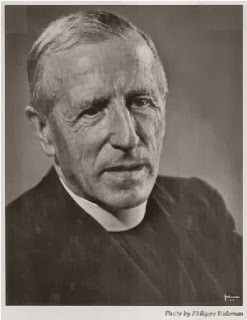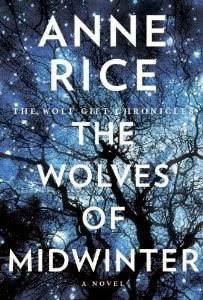For all those still reading this post on the old blog, I will keep these posts up for the next six or seven months before closing out the blog. I feel like I am extending the deadline of this old blog's existence ad infinitum, but there seems to be numerous followers of this older blog.
Link to New Blog: http://www.bibliophilesreverie.com/
The tale of THE WOLF GIFT continues . . .In Anne Rice’s surprising and compelling best-selling novel, the first of her strange and mythic imagining of the world of wolfen powers (“I devoured these pages . . . As solid and engaging as anything she has written since her early vampire chronicle fiction” —Alan Cheuse, The Boston Globe; “A delectable cocktail of old-fashioned lost-race adventure, shape-shifting and suspense” —Elizabeth Hand, The Washington Post), readers were spellbound as Rice imagined a daring new world set against the wild and beckoning California coast.Now in her new novel, as lush and romantic in detail and atmosphere as it is sleek and steely in storytelling, Anne Rice brings us once again to the rugged coastline of Northern California, to the grand mansion at Nideck Point—to further explore the unearthly education of her transformed Man Wolf.The novel opens on a cold, gray landscape. It is the beginning of December. Oak fires are burning in the stately flickering hearths of Nideck Point. It is Yuletide. For Reuben Golding, now infused with the wolf gift and under the loving tutelage of the Morphenkinder, this Christmas promises to be like no other . . . as he soon becomes aware that the Morphenkinder, steeped in their own rituals, are also celebrating the Midwinter Yuletide festival deep within Nideck forest.From out of the shadows of the exquisite mansion comes a ghost—tormented, imploring, unable to speak yet able to embrace and desire with desperate affection . . . As Reuben finds himself caught up with the passions and yearnings of this spectral presence and the preparations for the Nideck town Christmas reach a fever pitch, astonishing secrets are revealed, secrets that tell of a strange netherworld, of spirits—centuries old—who possess their own fantastical ancient histories and taunt with their dark, magical powers . . .
Countdown to The Wolves of Midwinter

Teilhard de Chardin 101: The Omega Point & Its Relation to Anne Rice's Wolf Gift Chronicles
Reading Teilhard De Chardin's text can be brutally difficult for individuals like myself, unaccustomed to reading abstract philosophy. Whenever I try to read hardcore, abstract philosophy, my brain feels shuttered and nonfunctional, as though the scattered neurons in my brain are struggling with valor and unabated enthusiasm to comprehend the deep implications of Teilhard De Chardin's theories. Strangely enough, I don't really feel particularly religious at this point in my life, but Teilhard De Chardin's ideas still deeply enthrall me with his ingenious theories about our place in the universe. For those who may not have heard of this brilliant, unorthodox thinker, Teilhard De Chardin was a very smart, progressive thinker in the field of biology during the early portion of the twentieth century. He believed that the theory of evolution shed a much deeper, more sophisticated light on the nature of the universe and how it may have been brought into being. Unfortunately, the Vatican at the time in the early twentieth century condemned such forward-thinking as blasphemous. Teilhard de Chardin was pressured by the Vatican to not publish his rather subversive works about his theistic evolutionary ideas. As such, they were not published till the sixties during the time of Vatican II, when the Catholic Church grew more accepting of a theistic idea of evolution.
Being raised in a Protestant Fundamentalist world that was stubbornly myopic about scientific matters, I never heard of Pierre Teilhard De Chardin until two years ago. Then again, I barely even knew about the existence of Philosophy, mysticism, or the notion that Biblical text could be read in the same way people read fantasy books or poetry. Then again, most people raised in the unenlightened, darkened world of secretariat religion or separatist fundamentalism tend to build their concept of God within a small, dark space that obdurately refuses to accept mystery, doubt, and paradox that are an essential part of the make-up of the universe. This type of restrictive fundamentalism believes the existence of all things is rudimentary, dry, and unsophisticated. Teilhard De Chardin's theories, including his concept of the Omega Point, are the antithesis of the mainstay fundamentalist theories that dominate the current Christian way of thinking. Again, his theories are not exclusively for Christians or evangelists. Teilhard De Chardin really wrote his theories to a more universal audience that goes beyond the cloisters of labels, and concerns himself with much deeper questions that go beyond the scope of convention. In many ways, he is no different than Carl Sagan, who was chiefly interested in the same types of existential questions:Why are we here? What is our purpose? Why are we even consciously inhabiting this universe, if we are led to believe that this universe has a beginning and endpoint with no underlying purpose for "being?" It is the latter question that the theory of the Omega Point strives to understand.
Definition of Omega:(Definition taken from FreeDictionary.com)
"omega [ˈəʊmɪgə]
n1. (Linguistics / Letters of the Alphabet (Foreign)) the 24th and last letter of the Greek alphabet (Ω, ω), a long vowel, transliterated as oor ō2. the ending or last of a series"Unsurprisingly, this word "Omega" designates an ending point, either within the realm of the universe's existence or a certain phase within someone's life. Essentially, it is a very agnostic word, when it relates back to the unanswerable God question. Teilhard De Chardin was an ordained, Jesuit priest, so his omega point theory definitely has Christian connotations. For agnostics or even atheists though, the word,omega point, can still cohere with our view of the universe being intrinsically mysterious or beyond our knowledge. Certainly, Teilhard De Chardin thought the same thing, as many other intelligent religious thinkers do. Sadly, some of the more boisterous religious thinkers are the often the more puerile, limited thinkers of this group, who would have made Teilhard De Chardin's theory of the omega point yet another dogmatic theory that adherents merely believe without question, but never really strive to reconcile or accept the paradoxes inherent in this theory. I think religious thinkers like Teilhard de Chardin or Madeleine L'Engle thought exploring and accepting paradox was a crucial part of their more relaxed notion of the word, belief.
Anyways, I was taken aback that Teilhard De Chardin's theory, though, was still very agnostic in my understanding. According to his theory, Omega Point simply relates to his theory that as the universe evolves and unfolds, material and conscious life progressively becomes more complex. Of course, his theory does relate back to the divine, when Teilhard de Chardin postulates that the omega point is the highest, predesignated stage of consciousness, where humanity or some other form of more evolved conscious life reaches the last phase of consciousness. Of course, my agnostic mind has no problem with this theory because it simply explicates the possible trajectory of conscious life, but it never provides any clear, determinant theories, as to when the omega point will be reached or any tangible sense of the factors that are constitutive of beings that have reached the highest stage of consciousness.
Relating to Anne Rice's works, this theory was very influential in the theistic evolution that was presented in Anne Rice's Memnoch the Devil, where Memnoch leads a reluctant, atheistic Lestat into the heavenly realms. This is where Anne Rice provides a much clearer illustration of Teilhard De Chardin's theory of the Omega point through her mastery of creating a complex, Faustian myth that presents a hero struggling with the meaning of existence and possibility that the whole construction of the universe was created through a form of theistic evolution. This form of theistic evolution is presented in Teilhard de Chardin-influenced way, where all material life is progressively evolving to an indeterminate end-point, where the highest stage of consciousness and material complexity within life is reached. In terms of Lestat's own development, the immortal consciousness of a vampire is already proof enough that biological life itself has the capacity to evolve and change over time. In Blood Canticle, Lestat strives to be a saint, as though to reach that higher level of consciousness as a vampire that will allow him to potentially transcend his more primal urges as a vampire. It is this insatiable primal urge, which St. Augustine would have phrased as concupiscence, that is still frustratingly intrinsic to all material life.
In Anne Rice's The Wolf Gift, the duality of the man-wolf is one of Anne Rice's most interesting mythological hybrids, which further emphasizes her continued exploration of the Teilhard de Chardin's notion of the omega point. During one particularly poignant scene when Reuben is seeking contrition from his Brother Jim, a priest, Reuben broodingly reflects upon whether God can really exist, when all material and conscious life seems to onerously struggle with the knowledge of one's own vices and paradoxical motivation within a theistic or even agnostic sense of the universe:
"Do you think Teilhard de Chardin could have been right? That we fear God does not exist because we can't spatially grasp the immensity of the universe; we fear that personality is lost in it when maybe it is a superpersonality that holds it all together, a super-conscious God who planted evolving consciousness in each of us-"(The Wolf Gift 221)This quote brilliantly encapsulates Anne Rice's own contention about Teilhard De Chardin's omega theory, which is a struggle to comprehend within a universe that seems as ineffably complex as our own selves or more evolved forms of biological life, such as werewolves or vampires. Interestingly, Nideck Point (the mansion that Reuben Golding eventually purchases) and the woods that surround this majestic, divine oasis are coexistent, and they structurally mirror the interior of dual nature of Reuben's own psyche. Even with this greater psychological complexity, the omega point is still an elusive end-point for any of the Morphenkind (Anne Rice's clever monicker for werewolves).
In The Wolves of Midwinter, the forest plays an even more pivotal role, as Anne Rice reveals more forms of highly evolved species with preternatural senses that continue to present Anne Rice's creative way of experimenting with the implications of the omega point within a world, where all biological life naturally has certain primal urges or limitations at all stages of evolution that sometimes can prevent a spices for a certain span of time from evolving to the next stage of existence until reaching the indeterminate Omega Point. Again, the omega point was never meant by Teilhard De Chardin to relate to New Age theories about the end of the world being caused by alien intervention. It was merely his theory of trying to understand the mechanics of evolution and a hypothetical look at where life will continue to evolve, according to his theistic understanding of the world.











1 comment:
Thank you for the fantastic post. I am a big fan of Pierre Teilhard de Chardin (I recently became aware of him also) and am enthralled with his ideas. I also very much enjoy Anne Rice, especially her earlier vampire novels. When I found out that "The Wolves of Midwinter" include references to Teilhard de Chardin I added it to my pre-order list. Looking forward to learning more.
Peace,
W. Ockham
www.teilhard.com
Post a Comment